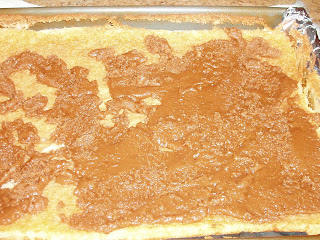Gigi's Fabulous Caramel Cake - made September 12, 2010 from Southern Cakes by Nancie McDermott
I almost didn't want to make this blog post because this recipe turned into a half-failure and I hate when that happens. But failure and confession is good for the soul and I decided I needed to 'fess up. Not everything I make turns out but I learn from it for next time and that's all I can ask. For one thing, the cake itself lives up to its name and it really is fabulous. If you want a good vanilla cake, make this cake. Only don't make it with this frosting because that's the failure part. I'm not quite sure what I did wrong or whether it's the recipe or really me. I followed the instructions almost to the letter. The almost part is I substituted whole milk for the evaporated milk. I also only used half the frosting recipe since I was making this as a 9 x 13 cake and not as two round layer cakes. But I still don't think that accounted for the colossal failure that was my caramel frosting.
Here's the picture from the recipe book on what the finished cake and frosting are supposed to look like:

Lovely, isn't it?
Er, here's what mine turned out like:

Not quite so lovely, right??!? The frosting was thick and difficult to spread, even when warm, even after I added more milk. It was just grainy. I don't know if I overcooked it since it also turned out darker than in the book picture. But the true failure was in the taste test. While the cake itself was delicious, the frosting was like eating brown sugar out of the box. I'm not a big fan of frosting to begin with but, while I have a high sugar tolerance, even *I* do not make a habit of eating straight brown sugar and that's what this tasted like.
It wasn't a total loss as I now have a great vanilla cake recipe to use but next time, I'm going to pair it with a real vanilla frosting. But the main point I wanted to make by posting this is everyone has failures, myself included. I get some emails with people telling me a recipe they tried from my blog didn't turn out like mine - sometimes it's because they inadvertently left out an ingredient (Rhuwena forgetting the sugar in the pumpkin upside down cake), sometimes it's because they did a horrific substitution (margarine instead of butter - wah), or sometimes because they overbaked it. The point is - that's okay. Try and try again until you get it right. That's what I intend to do.
Yellow Cake
3/4 cup (1 1/2 sticks) butter
1 cup milk
2 cups sifted all-purpose flour
2 3/4 teaspoons baking powder
1/2 teaspoon salt
4 eggs
2 cups sugar
1 teaspoon vanilla extract
Gigi's Caramel Icing
One 1-pound box (about 2 2/3 cups) light brown sugar
1/2 cup (1 stick) butter
7 tablespoons evaporated milk
1 teaspoon vanilla extract
1. To make the cake, heat oven to 325˚F. Grease and flour two 9-inch round cake pans. Combine the butter and milk in a small saucepan, and cook over low heat until the butter melts. Stir well and let cool to room temperature. 2. Meanwhile, combine the flour, baking powder, and salt in a medium bowl, and stir with a fork to mix well. In a large bowl, combine the eggs and sugar, and beat well at high speed, scraping down the bowl often, until light yellow, smooth and thick.
3. Stir the flour mixture into the egg mixture, mixing only until the flour disappears. Add the cooled milk mixture and the vanilla, stir well, and divide the batter between the prepared pans.
4. Bake at 325˚F for 25 to 30 minutes, until the cakes are pale golden, spring back when touched lightly in the center, and begin to pull away from the sides of the pans.
5. Cool in the pans for 10 minutes on wire racks or folded kitchen towels. Then turn out the cakes onto wire racks or plates to cool completely, top side up.
6. To make the icing, have the cake layers handy and ready for frosting, so that you can spread the warm frosting quickly once it is ready. In a heavy medium saucepan, combine the brown sugar, butter, evaporated milk, and vanilla. Bring to a boil over medium-high heat. Stir well and then adjust the heat so that the frosting boils and bubbles gently. Cook for 7 minutes. Remove from the heat and let cool for 5 minutes.
7. Beat the warm icing with a wooden spoon until it thickens, 2 to 3 minutes. Place a cake layer, top side down, on a cake stand or serving platter. Quickly spread some icing over the top and cover it with the second cake layer, top side up. Ice the top quickly and then spread the remaining icing over the sides.
8. If the icing becomes too hard to spread, warm gently over low heat, add a spoonful or two of evaporated milk, and then scrape and stir well until the icing softens enough to spread again. Dip a table knife in very hot water to help soften and smooth out the icing once it is spread.
















